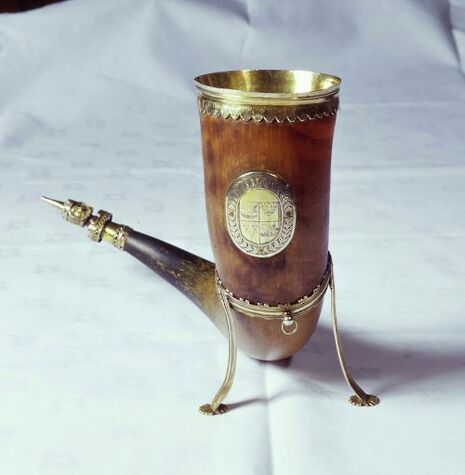The History of a Cantabrigian Student in Nine Objects: Part 2 – The Corpus Christi Great Horn
In the second instalment of this series retracing the history of a Cantabrigian Student, Professor Autuneuille presents to us The Corpus Christi Great Horn

2. The Great Horn
Auroch horn drinking horn, on loan from Corpus Christi College, Cambridge
AD 1200-1300
The receptacles from which we have quenched our thirst have evolved over the centuries. Our earliest forefathers probably set themselves down to drink like Gideon’s Israelites in Judges (7:5):
So he brought down the people unto the water: and the LORD said unto Gideon, Every one that lappeth of the water with his tongue, as a dog lappeth, him shalt thou set by himself; likewise every one that boweth down upon his knees to drink.
But among that host numbered three hundred, civil and Godly soldiers, who used the most rudimentary of receptacles- cupped hands (7:6):
And the number of them that lapped, putting their hand to their mouth, were three hundred men: but all the rest of the people bowed down upon their knees to drink water.
And it was with these ones that Yahweh rescued Gideon and pursued the Midianites ‘as far as Beth-ha-Shittah in the direction of Zarethan’, putting Midian in his power. Since, our ancestors have drunk from cups of earth, wood, metal, ivory, horn, glass, paper and plastic. The material and shape of the implement tells the story of an epoch and its revelers. Drinking horns have existed since classical antiquity, seeing prominence in the Viking Age, use in the Medieval period, and resurgence in the Romantic Period. The Great Horn is a beautiful example of a Medieval drinking horn, fashioned from the crown of a fearsome aurochs, extinct ancestor of modern cattle. Their closest modern semblance is the breed of Spanish fighting bulls, which, though smaller, conserve a terrifying cocktail of aggression, energy, strength and stamina.
The descriptions of Beowulf’s fresher’s week in Heorot pre-empt modern festivities by a millennium. He was with his friends, he’d booked a table in Life (being well-adorned with rings, this was something he could afford), he had ordered a crate of VKs and was loving the tunes:
Then a bench was cleared in that banquet hall so the Geats could have room to be together and the party sat [at their pre-booked table], proud in the bearing, strong and stalwart. An attendant stood by with a decorated pitcher, pouring [very] bright helpings of… [VK]. And the minstrel sang, filling Heorot with his head-clearing voice, gladdening the great rally of Geats and Danes [with some modern classics- e.g. Sweet Dreams by the Eurythmics].
Beowulf, 491-498.
Now, the Rugeloût institute has always been a fun-loving place- we like to have a good time. In 2007 we had our first Night at the Museum party (sponsored by Haribo) and the annual pantomime is a raucous affair. However, the Institute cannot be seen to promote licentiousness and even the Vikings knew the dangers of excess. No one put it better than the shifty-eyed spear shaker, Odin, the far-seer:
A bird of Unmindfullness flutters over ale-feasts,
wiling away men's wits;
with the feathers of that fowl I was fettered once
in the garths of Gunnlodr below.
Drunk was I then, I was over-drunk,
in the fold of wise Fjalar;
But best is an ale feast when a man is able
to call back his wits at once.
Hávamál (Sayings of the High One)
Enjoy the festivities. Be not driven to folly.
Read on next week, to see what fascinating object we’ll have in store for you in this brand new series of The History of a Cantabrigian Student in Nine Objects.
 Interviews / ‘People just walk away’: the sense of exclusion felt by foundation year students19 April 2024
Interviews / ‘People just walk away’: the sense of exclusion felt by foundation year students19 April 2024 News / Copycat don caught again19 April 2024
News / Copycat don caught again19 April 2024 News / AMES Faculty accused of ‘toxicity’ as dropout and transfer rates remain high 19 April 2024
News / AMES Faculty accused of ‘toxicity’ as dropout and transfer rates remain high 19 April 2024 Theatre / The closest Cambridge comes to a Drama degree 19 April 2024
Theatre / The closest Cambridge comes to a Drama degree 19 April 2024 News / Acting vice-chancellor paid £234,000 for nine month stint19 April 2024
News / Acting vice-chancellor paid £234,000 for nine month stint19 April 2024





